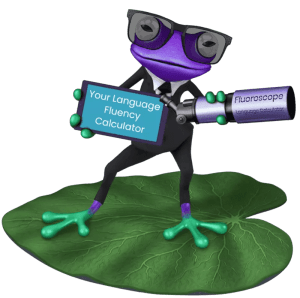English Speaking Practice to Improve English Fluency, Your Road to Success

English is used in more countries than any other language in the world. With over 1.5 billion native and non-native English speakers worldwide, it’s not difficult to comprehend its prominence. As access to travel, global commerce, and online communication continues to grow, fluency in spoken English has turned into the most coveted skill in contemporary times. It has become more of a requirement than a luxury at this point in history. While writing asserts its dominance in the Business English world, speaking takes supremacy in overall communication.
Nevertheless, learning English, or any language for that matter, is an uphill battle. Fortunately, there’s a wealth of resources accessible to any language learner seeking to enhance their English speaking skills. No matter your English level, you’re surrounded by activities that demand a certain extent of familiarity with the English language: traveling, buying foreign brands, using social media platforms, studying overseas, consuming popular media, and so on. You can use these conditions to your advantage.
Read on for a comprehensive guide to language principles and learning strategies that develop fluency in spoken English effectively.
Main Routes to Improvement
The framework of fluency comes down to strengthening two subjects in language learning: pronunciation and vocabulary. Furthermore, study and practice are the main routes to making progress in these areas.
Pronunciation
Learning pronunciation isn’t just an endless exercise of “listen and repeat”. Drills are part of it, but pronunciation is more than that. It’s closely tied to skills in vocabulary, speaking, and listening. It’s also not limited to only knowing how letters and words sound. Important features such as connected speech, intonation, stress, and accent contribute to correct pronunciation.
The way you pronounce words has a significant effect on your communication skills. You could eliminate all grammar mistakes and use vivid and idiomatic vocabulary, but all of that means very little if no one understands your pronunciation.
The trickiest thing for many English learners is the fact that pronunciation is just as much a physical skill as an acquisition of knowledge. How your mouth, tongue, and jaw move affect the sound you produce. This is why frequent practice is a key factor in improving it.
One of the well-known pronunciation issues is the divergence between English and the learner’s native language. We’re all born with the ability to discern and copy all the sounds of any human language. As infants, we start to distinguish the sounds that are relevant when we speak our language and discard the rest. Consequently, with age comes the difficulty to perceive distinctive sounds from different languages, which is why we have trouble mimicking them.
Although the path to accurate pronunciation has no shortcuts, there are techniques you can employ to speed up the process. Purposeful listening is one of them, and studying the English language phonemic chart is another. Learning the limitations set by your native language is also valuable as it will make it much more manageable to break through those limits.
Vocabulary
Studying vocabulary entails several activities where other skills are incorporated: reading books, listening to podcasts, watching videos, and utilizing learning software like LillyPad.ai to name a few. Forming habits around these activities is an important part of expanding the scope of your vocabulary.
Reading blog posts or online articles is a great place to start. As your vocabulary builds, you can take on more challenging materials like short stories, poetry, and novels. This is the most straightforward approach to learning new words and how they’re used in different contexts. Another way of broadening your vocabulary is to watch videos and listen to audio sources. These activities will let you observe vocabulary in action.
In addition, purchasing and using interactive English language apps or software is a notable avenue for improving your vocabulary. LillyPad.ai is a prime example of an integrated and comprehensive learning platform. Not only will you have access to an enormous library of carefully curated reading and listening materials, but you also have your own space to make, customize, and track your learning activities.
Perhaps the most important manner of solidifying your vocabulary is practice or application. Many English language learners fall into a habit of gratuitous memorization. The passive learning of vocabulary, which usually involves learning word lists by rote, is ultimately ineffective. Imagine learning 50 words daily (that’s a whopping 350 words a week!), testing if you remember them, and then moving on to the next list.
On the other hand, active learning is creating an environment where you can put vocabulary to use. The same amount of time memorizing lengthy word lists can be spent learning 5 to 10 words and doing language exercises where you actually use the vocabulary you’ve learned. Active vocabulary learning can be done in several ways, e.g. practicing with a language partner, compiling a vocabulary notebook with categories and sentence samples, doing speaking exercises while recording yourself, and much more.
Naturally, the best strategy to improve speaking skills is to take opportunities to talk as they come along. With a growing vocabulary to support expression, you’ll become more comfortable and articulate when speaking English.

Best Practices for Improving Speaking Skills
A myriad of methods have been theorized and implemented for each of the main English skills, not the least of which is speaking. Many of these methods have been tried and proven. Still, they’re largely dependent on the language learner’s preferences and receptiveness to the exercise.
Obviously, you can always test different methods and evaluate their efficacy in your English learning journey. But there are general practices that define the basic principles of speaking skills improvement. By knowing them, you can establish an ardent foundation or amend and reinforce an existing one.
Speak
Admittedly an obvious goal but a reminder that shouldn’t be taken lightly. Many language learners have a desire to study but fail in due course because of their reluctance to talk. While introversion and stubbornness are parts of a person’s individuality, a lack of enthusiasm or initiative to speak won’t get a student far in their process of learning. In fact, people who have learned second languages in the past lose their proficiency after a period of not using them.
In most cases, ELLs who study in their own countries fall under language circumstances that work against them. There are limited if not zero environments or opportunities to speak English. For this reason, it’s even more imperative for learners to seek out any possible chances to practice speaking. If the odds point toward the classroom, what language learning value can a student acquire if they don’t even speak in their English classes?
Of course, self-study can’t be discounted. A great number of English learners have accomplished remarkable things by creating their own English environment. This involves constant exposure to the language, which means hours upon hours of English media consumption, routine usage of interactive tools, self-recording and monitoring, and so on. These learners’ success is fueled by effective learning skills and habits, immense diligence, resilience, and fortitude.
However, real-life application is still necessary for most people to properly advance their fluency. If learners with inadequate language exposure can make friends with like-minded people (or native speakers if they’re able to), they can organize regular meet-ups for knowledge-sharing and practice. Having said that, there’s also a huge difference between looking for chances to speak English and forcing a conversation, especially when talking to friends.
Instead of pre-empting an English conversation by considering grammatical rules and perfect vocabulary, treat the situation as you would any real conversation. So speak, as often as humanly possible. Just avoid a 10-minute impromptu pronunciation practice in the middle of a social gathering.
Reflect
Self-assessment is an indispensable practice to increase speaking skills. Being aware of your strengths and weaknesses in spoken English will considerably help in identifying language areas for further improvement.
Recording yourself during a speaking activity, be it on your own or with a partner, is a painstaking but definitely useful exercise. It’s normal for learners to catch language mistakes when other people are making them. Listening to a recording of your speech or conversation simulates the same situation. You can promptly spot wrong vocabulary, pronunciation, and grammar.
Another mode of self-evaluation is to ask yourself three critical questions: 1) Where did I do well?; 2) What can I improve on?; 3) How can I use my new knowledge?
This method is helpful to shape the direction of your studies. Your answers will pinpoint if there’s a need to modify the way you study or if some learning materials may not be working for you. Teachers use a similar or elaborate version of this assessment called needs analysis, which is a tool that helps them design, implement, and revise courses with students’ needs in mind.
Relax
Self-training for speaking fluency can be stressful. Dealing with the pressure to reach personal and academic standards is a struggle for many English students. Some non-native English speakers belong to cultures that view relaxation as the polar opposite of work. But the mind and body have limits, and overworking is more detrimental than it is advantageous to success.
For one, thinking is arduous when you’re wound tightly. You won’t be able to remember vocabulary, let alone speak well if you’re anxious or tense. Since stress is a normal tradeoff in any undertaking, the ability to cope with it makes the process of learning more manageable and rewarding.
Pressure in language learning is intensified by unrealistic or unclear goals and a terrible sense of urgency. The temptation to achieve a lot in a short period is strong and tough to shirk off. Adjusting the mindset can alleviate this. It’s good sense to remember that becoming a fluent speaker takes time, and learners who toil mindlessly towards unworkable benchmarks are set to fail.
Taking short and episodic rests during your study sessions can do wonders in refreshing your brain and keeping you energized. Or having just good habits in general, like doing regular exercise and getting sufficient sleep. Below are the top relaxation techniques proven by language learners to keep stress at bay:
- Physical exercise.
- Listening to music.
- Get the right snacks.
- Call or meet a friend.
- Proper time management.
- Prioritize your sleeping habits.
- Take a short walk or spend time outside.
- Breathe, stretch, and splash your face with cold water.
More importantly, many language learners can benefit from a kinder attitude toward themselves. They can do this by setting achievable goals, making a wide space for mistakes, and not dwelling on the errors they make. It’s all part of learning. Nobody can jump from beginner-level conversation skills to advanced levels overnight. English students should learn to take these learning pains in stride, even laugh at them and start again.

A Closer Look at Pronunciation and its Features
English phonology is a tremendous branch of study within the English language. The key to building a solid foundation in pronunciation, however, is understanding the features that are applicable to the production of natural speech. These critical features that contribute to an efficient speaking flow are syllabic stress, intonation or pitch, connected speech, and accent.
Stress
The emphasis given to a word’s syllables is called stress. Stressed syllables are pronounced louder or longer than unstressed syllables. English is a stress-timed language, which means syllabic stress appears at a regular beat. When words are spoken separately, non-stressed syllables are shortened. But in natural speech, when a word is spoken in relation to other words in a sentence, non-stressed syllables can disappear completely.
There’s a simple but helpful chant that learners do to get into a syllabic-stress headspace before pronunciation lessons. (We’re going to need Leonardo Da Vinci on this one.) They use the name Mona Lisa to enact syllabic stress. In this exercise, they speak Mona Lisa four times, emphasizing a different syllable with each iteration. They repeat the chant, increasing the speed in every repetition. The chant goes:
MO-na-li-sa, mo-NA-li-sa, mo-na-LI-sa, mo-na-li-SA
To further illustrate the importance of stress (and this is something you may have already observed), many two-syllable verbs have an emphasis on the second syllable. But due to language evolution, the same words can be used as nouns. The noun form doesn’t change except when spoken, because the stress is now on the first syllable. Here are a few examples:
- To permit a permit.
- To address an address
- To transport a transport
If you read the phrases silently but heard the appropriate syllabic stress in your head, then you have a functional grasp of what stress means in pronunciation. You may read the phrases aloud for good measure.
Intonation
A pronunciation feature present in all languages is intonation. This focuses on how we say something in terms of rhythm and pitch. It’s the “music of the language”, if you will. To achieve the sound of English speech, we can treat intonation as the way we use our voices to communicate certain feelings and meanings.
Since English-language movies and TV shows dominate popular global media, there are millions of people worldwide exposed to the intricacies of English-language intonation at any point in time. Language teachers and learners possess the advantage of witnessing English in practical use and integrating it.
Let’s take a look at the main functions of intonation: grammatical and attitudinal.
Grammatical intonation corresponds to specific grammar structures, and this is most apparent in questions. Closed-ended questions, or questions answerable by yes, no, and other variants, have an upward or rising intonation. Open-ended questions, or questions that require more detailed answers, have a downward or falling intonation.
Attitudinal intonation enables the listener to understand what the speaker feels: joy, anger, interest, ennui, surprise, and so on. For instance, after asking a friend how they’re doing and they answer with a dismissive-sounding “I’m fine.”, you know instantly that something’s wrong. In the same thread, an expression of thanks towards a utility bill delivery will sound less heartfelt when uttered to some who returned a missing wallet. Vocabulary and intonation are used in congruence to get a sincere message across. But in many cases, we use intonation to express genuine emotions perhaps more than the actual meaning of the words we say.
For language learners, being simply aware of intonation is the best way to improve. By purposefully listening to podcasts or watching recorded conversations, they can notice how intonation works in natural speech. Similarly, teachers can include a level-appropriate version in their English lessons. They can pick celebrity interviews, scenes from students’ favorite movies and TV shows, excerpts from famous speeches, and snippets from news reports or documentaries. Language learners can benefit from observations shared in class.
As a variant of this method, students can record their own dialogues and check with the rest of the class if their intonations conveyed the right emotions. Teachers can also use scripts for the recorded activity and the class can decide which student, pair, or group sounded the most natural.
The good news is, it’s been proposed that English students are likely using the correct intonation a lot of the time and that even a monotonous tone won’t really cause a major failure in communication. However, the goal of using intonation with accuracy, subtlety, and confidence requires constant practice.
You can better imitate its use when you have more exposure to it. Outside a classroom setup, one of the most valuable methods in evaluating your improvement is to record and listen to your own voice.
Connected Speech
Connected speech, also called connected discourse, is how spoken language sounds in normal conversation. In this context, some words or syllables are reduced or clipped, phrases sometimes run together, and words are stressed differently than they would appear in writing. Many words are pronounced differently in isolation and sounds can disappear entirely in casual conversation.
Think of it as verbal shortcuts used by native speakers. These are non-standard usages of common words in English speech, and although they can be spelled out, they’re not used in formal writing.
From an academic standpoint, connected speech is too specialized to include in the usual ESL curriculums. One way or another, studying it in depth isn’t quite useful. But knowing how it happens can foster a deeper understanding of a learner’s listening and pronunciation limitations, and can lead to adequate imitation.
In connected speech, sometimes sounds are deleted, changed, or added. Anyone is familiar with the ubiquitous “wanna” and “gonna”. For the sake of knowledge, let’s get a general idea of the different kinds of connected speech.
1.) Linking or Catenation – blending when one word ends with a consonant sound and the next word starts with a vowel sound
- cats or dogs – catserdogs
- this afternoon – thisafternoon
2.) Intrusion – an additional sound “intrudes” between others.
- shoe on – shoewon
- he asked – heyasked
3.) Elision – a sound is eaten by a similar and stronger sound next to it.
- used to – useto
- most common – moscommon
4.) Assimilation – two sounds blend and create a new one
- did you – didju
- meet you – meetchu
5.) Geminates – like the twins, Gemini. One word ends with the same letter that begins the next word:
- want to – wanto
- social life – socialife
Non-native speakers commonly get confused when native speakers use connected speech. Native speakers who are aware of this situation would often enunciate or speak more slowly to their non-native friends, pausing and repeating considerately. Language learners need to study and regularly listen to connected speech to train their ears and recognize it with ease over time.
Accent
An accent is the melody and rhythm of any language. Foreign language learners are accustomed to this but many misguidedly assume that it’s the same as pronunciation. It isn’t. An English student with a foreign accent can pronounce words impeccably.
This isn’t to say that accent doesn’t contribute to unclear pronunciation. A thick accent sometimes constrains a learner’s attempt at English speech, making the effort sound garbled and strained. As a matter of fact, reducing accent is a well-known pronunciation issue.
The problematic part is that an accent problem is often treated as a pronunciation problem. For instance, it’s a popular fact that some East Asian languages don’t distinguish between the l and r sounds of English. This has nothing to do with accents.
While accent reduction could make pronunciation easier to hear, language learners don’t have to get rid of theirs. If they do prefer to lose their accent, emphasizing the proper usage of intonation and pitch, and the exact application of connected speech will help them obtain the neutral or native sound faster.
Pronunciation Activities for all Levels
Teaching English pronunciation is an interesting challenge with different goals for each level. As can be expected, every grade has its own issues that ought to be addressed. Another important thing is to avoid overwhelming the class with a big quantity of material that the students aren’t ready for. Learning should be done at a sensible pace. As long as the program has clear goals and reasonably-scheduled targets, teachers can create an environment with the least amount of pressure.
Many older learners have the tendency of getting flustered and frustrated at the drop of a hat. Students who are irritated by their slow progress may refuse to continue. So it’s also a great idea to set the right expectations. Explain that pronunciation involves muscle coordination which takes time and a lot of practice. Encourage them to engage in classroom activities, which can include games, reading aloud, and drills. Create an atmosphere where they can laugh at their mistakes and help each other meet their pronunciation goals.
Beginner Level Pronunciation
Generally, rote learning is the most applicable at this stage as students have to develop their proficiency with pronunciation basics. Learners have to develop skills through repetition, which is why drills and chants are especially useful at this level. Patterns need to take primary focus after learning the basic vowel and consonant sounds of the alphabet. Some examples of patterns are:
- Syllabic stress – This is a pertinent subject that must be learned as soon as multisyllabic words are introduced.
- Silent letters – To demonstrate silent letters, use examples such as hour, island, or comb, and the endings of past forms of regular verbs.
- Voiced and voiceless consonants – The most common and effective way to show the difference is for students to touch their throats and feel the vibrations that the sounds produce or the lack thereof. Voiced consonants: b, d, g, j, l, m, n, ng, r, sz, th, v, w, y, z. Voiceless consonants: ch, f, k, p, s, sh, t, th.
Activities you can do in class:
- What’s My Phone Number? – Draw a dialing pad on the board. Designate a word for numbers 0 to 9. Read the words out loud and the students will write the corresponding number on their paper.
- Slap That Word! – A fun competition between pairs or among groups of students, depending on time and class size. Students associate words that are written or posted on the board/wall. The teacher speaks a word out loud and students run to find it. The first person to slap the word earns the point.
- Read and Rhyme – The teacher prepares flash cards. Students have to give a word that rhymes with the one presented.
Intermediate Level Pronunciation
At this level, English learners should feel comfortable with simple patterns in English pronunciation. They’re ready to study short sentences and the subject of intonation can be introduced. Additionally, intermediate-level learners have adequate skills to start learning the International Phonetic Alphabet (IPA). Daily practice should include:
- Minimal Pairs – Studying the minor pronunciation differences between similar words will develop skills to recognize, understand, and speak them. Frequent use of minimal pairs builds awareness of sound distinctions. Examples of minimal pairs: thing/sing, bat/pat, while/white.
- Word Stress Patterns – Do activities that center around short and simple sentences and standard word stress patterns.
- Stress and Intonation – Introduce the necessity to follow the music of English and give plenty of examples that demonstrate how it’s used in sentences.
Activities you can do in class:
- Tongue Twisters – A great way to train mouth muscles. It’s also fun for students to make an effort to become the first ones to speak the tongue twister correctly. By creating an aura of communal success, their drive to accomplish the task will gradually increase the clarity of their pronunciation. Tongue twisters can be applied at any level but with adjustments in difficulty.
- IPA Card Game – This method will enhance the recall of phonetic symbols. Use flashcards with pictures to nurture association.
Advanced Level Pronunciation
High intermediate to advanced level learners should be trained continuously in stress and intonation. They already have a handle on the basics of each phoneme, the syllabic stress of words spoken individually, and the stress patterns of short to mid-length sentences.
Students at this skill level tend to focus on the correct pronunciation of words in isolation so the importance of intonation must be reinforced. Soon they’ll be able to grasp contextual meaning through word stresses in sentences and apply it to their own pronunciation. Advanced level learners should be honed in the following:
- Use of Register and Function
- Understanding Stress and Intonation
Activities you can do in class:
- All the previous activities but with higher difficulty and longer sentences.
- IPA Transcription Lesson – An activity that strengthens knowledge of reading IPA.

Classroom Activities to Improve Vocabulary Skills
The number of classroom activities used by teachers, both in regular and language schools, is as enormous as you can imagine. The novelty of some conventional language learning devices does retain its value when used with a dollop of creativity. But materials and activities such as vocabulary flashcards, quizzes, common phrases tasks, dedicated practice time, audio recordings, mock job interviews, journals of common sayings, and so on may not be the best strategies when used in their dreary state. They won’t help learners achieve real progress in their fluency goals.
There are other concepts you can use in harmony with an old reliable chest of tools to elevate your curriculum’s relevance and effectiveness. Here are some ideas that you can apply in your lessons. They may serve as secret weapons to arm your students as they forge along the path to fluency.
Paraphrasing
Simply put, paraphrasing is saying the same thing in a different way. For a plain example, the sentence “Smoking is not allowed.” can be paraphrased into “This is a non-smoking area.” or “Smoking is prohibited here.”
The process of paraphrasing is typically condensed to 4 R’s:
Read – understanding the text.
Restate – restate the text in your own voice/way/style.
Review – check if all the vital points are covered.
Repair – correct/modify your paraphrased version of the text.
In essence, there are 3 ways to paraphrase. The first method is to use synonyms. Choose words in the text that you can replace with their closest synonyms in context.
The second is to transform verbs. If the original text uses the active voice, you can paraphrase using the passive voice. Or use gerunds and infinitives alternately.
The third is to alter the sentence structure completely. This requires the highest skill of the three as the end result can appear totally unrecognizable from the original text. A more advanced way is applying all three methods to a block of text.
Using Context
Some language learners get stuck with the common usage of the words they learn. For example, if a teacher asks several students to use the word “travel” in a sentence, they’re more likely to use the word within the confines of its obvious meaning such as “I will travel to South Korea next year.” Or “Traveling is exciting.” Or “I like to travel because I love visiting new places.”
However, when you introduce the element of a particular situation, hence “context”, the students become more inventive or entertain different perspectives. It’s a great exercise to connect words or ideas that they normally don’t associate together.
A teacher’s instruction could go like this: “Use the word ‘travel’ in a sentence under the context of ‘education’.” Students will have to think of school-related ideas to use the word with. The teacher will get sentences such as “The headmaster wants to travel to the countryside but he’s busy.” or “We traveled to the island to study local marine life.”, and so on. The teacher can use any topic they want.
Circumlocution
Plainly put, circumlocution means “deliberate wordiness”. To use this strategy in a vocabulary exercise, teachers hand out lists of phrases or sentences and pick out a word that students should replace. But instead of looking for the perfect synonym, students should use their own descriptions of the word based on how they understand it. The results can be awkward. However, the goal isn’t to be grammatically correct but to enhance the skill of defining or explaining ideas.
For example, the sentence is: “My best friend and I went to the museum to watch an exhibit.” The teacher chooses “museum” as the target word. The teacher can ask several students to try the method with the rule that they can’t repeat their classmates’ answers. The class can do this until they’ve exhausted every possible description. Students will come up with sentences like:
- My best friend and I went to that building near the park to watch an exhibit.
- My best friend and I went to that place where they display many bones to watch an exhibit.
- My best friend and I went to that structure with many historical collections to watch an exhibit.

The Vocabulary Bank: From Dormant to Dynamic Learning
Building English vocabulary is a major component of advanced speaking skills. But as we’ve mentioned earlier, the sole practice of memorizing words till the cows come home won’t accord any value to your language growth. Learning vocabulary should be active or practical, which means using your knowledge in actual English conversations. But what if you’re burdened by the following constraints:
- You’re enrolled in an hourly English language class that meets only three times a week.
- You don’t have the time or budget to attend more classes.
- You live in an area where occasions for speaking English are limited.
- You have a group of friends you can practice English with but the meetings aren’t regular or particularly enthused.
What kind of self-study tactics can you exploit to work in conjunction with your English class? You’ll need motivation, commitment, a notebook, index cards, and a box.
Keeping a Personalized Vocabulary Notebook
It seems old-fashioned and elementary, but it works if you’re dedicated and enthusiastic to try it out. Think of it as creating a vocabulary bank. The initial foundation may take a bit of time, so allot a generous schedule for it. A whole day if possible and follow these steps:
- Gather all the notes from your previous English classes and self-study sessions.
- Pick words, phrases, or sentences you like and write them on a piece of paper that will serve as a draft or vision board.
- Think of categories that you can compile the words under. Don’t be greedy in thinking of all possible classifications. You can always add to them later. You can be as general (sports, travel, film, food) or as specific (bad dialogues from my favorite horror movies, things a foodie might say, funny one-liners from American superhero movies, phrases from lyrics of English music, variants of the word “speak”) as you like.
- Compile the words into their categories or themes.
- Copy all of it in a separate notebook, which will become your first “bank”. Ideally, use one page per category, but you can allocate a few more pages to each theme. You’ll be adding more content later. TIP: you might want to designate the first page as your list of contents and number your pages as well.
- Review the words you’ve written. You can write their respective translations in your native language, preferably in smaller type and with a different color pen.
- Keep adding words or new categories as it serves you.
How is this different from a typical compilation of word lists? The possible answers are only as endless as your imagination:
- Just by spending that amount of time with the words, drafting and copying them, you’ll retain the knowledge of at least half of them.
- Now that you’re done with the primary steps, it won’t be as time-consuming or require as much brain power to make additions under each theme every time you learn new words.
- When you remember a word but forget its meaning, you’ll know where to find it.
- As an extended exercise to activate retention and application, you can write sentences or phrases for each word.
- When you need an activity to pass the time or to supplement vocabulary learning, you have a store of words you can refer to.
- Spend any amount of time on any number of days a week to write a paragraph from a selection of words. Start with a small collection, say 5 words. Read your paragraph aloud and record yourself. Pay attention to your pronunciation and intonation.
A Box of Words
Let’s dial things up to eleven. Or perhaps journaling just isn’t your style and you want to keep writing to a minimum. Making a vocabulary box is a viable alternative:
- Get a box and a pile of index cards.
- Check your language notes and choose some words.
- Write one word per index card. If the index card is too large or your handwriting needs a magnifying glass, you can cut the cards in half or fourths.
- Put the cards in the box.
- During any chunk of free time, pick a word from the box and say its meaning out loud.
- You can use the word in a sentence.
- If you feel predominantly keen, pick three cards. Use all the words in a single sentence.
- Why not get two small boxes? Or use a divider in a big one. One box or partition should contain topics (family, workplace, free time, café). The other should hold ordinary words. Pick one card from each box/partition and use the ordinary word in the context of the topic.
- Since we are on the subject of creating partitions, an alternative can have 4 categories. To start with: people, places, actions, animals. Let’s say you picked the following words correspondingly: fireman, desert, dance, octopus. You can come up with sentences such as “The fireman went to the desert and saw a dancing octopus.” Or “The fireman danced like an octopus in the desert.” Bam! Active learning and effective vocabulary retention.
- Share in class, with a partner, or with a group.
Even if the language odds aren’t in your favor, you shouldn’t settle. Necessity is, after all, the mother of invention.

Speaking Exercises Using Sentence Guides
Since an inherent principle behind improving fluency is to speak as much as possible, it’s somewhat ordinary for teachers to spend a large portion of their classes on speaking exercises. After a discussion on concepts and language requisites, teachers normally facilitate “speaking time”. Unfortunately, requiring students to talk can sometimes be akin to pulling teeth, and speaking time becomes quiet time. This disinclination to speak is mostly rooted in fear, uncertainty, or a lack of ideas. The regular practice of simply asking questions for students to answer at length may not be the best way to encourage them to talk.
Classroom management plays a big role in this regard. It’s important for teachers to encourage an atmosphere of collaboration, community, trust, and humor. Students need to feel comfortable, that they won’t be put on the spot, forced to produce speech, or laughed at and criticized whenever they make mistakes. A strategy teachers can utilize is applying sentence guides. This scaffold of sorts for guided speech leaves a wide room for ideas and can be adjusted to its simplest forms. Teachers can raise the complexity of the exercise when students are ready and motivated to take on a bigger challenge.
- PRE/PDE
Depending on the question, PRE/PDE requires at least 3 sentences to answer speaking activities. The acronym stands for Point (answer), Reason or Detail, and Explanation (example). Teachers can demonstrate first before asking the students to use the guide. Here is an example:
Question: Do you like the winter season?
Answer:
Point – Absolutely not.
Reason – I feel miserable when it’s cold.
Explanation – I don’t like having to wear many layers of clothes each time I need to go out.
Teachers can later require students to include more elements in each sentence or to give two or more reasons/details with subsequent explanations.
- PPF
The acronym signifies Past, Present, and Future. This targets specific language such as verb tenses, and phrases to express time, probability, and predictions.
Question: Talk about what you look for in a company.
Answer:
Past – I used to think money is the most important thing.
Present – But nowadays, I think company culture is equally important.
Future – In the future, I’d like to find a company with supportive bosses and coworkers.
This exercise can be as complex as the teacher wants, such as requiring an additional response or more elaboration for each segment.
Improving Your Speaking Fluency with LillyPad.AI
Getting superior educational value at an affordable price is hard to come by. Whether you’re a teacher or an English language learner, getting LillyPad.ai may just be the best investment you could make for your profession or language studies. You can also enjoy the free trial period: but fair warning, you might discover that LillyPad.ai is the only English learning software you’ll ever need.
The platform’s Pronunciation Section allows you to listen to the authentic or real-life speech, record your voice as you read along, and get feedback. The Vocabulary Section contains a huge library of words with real-world examples and vocabulary quizzes. And that’s only the beginning. Users have access to a carefully curated library of interactive reading materials.
They also enjoy their own individual space to store and track their activities and progress. Each team member behind LillyPad.ai is an expert in their field, collaborating to integrate the most useful and helpful content in English language instruction for all participants in the ESL/EFL community.
Conclusion
Studying and practicing pronunciation and vocabulary are the best methods to develop fluency in spoken English. Pronunciation skills can’t be developed by rote alone. Awareness and application of certain features of pronunciation, namely syllabic stress, intonation, connected speech, and accent all have a substantial influence on speaking-skill enhancement.
Learners with different aptitudes in pronunciation should train accordingly for the best results. In consolidation, vocabulary is the second factor towards fluency in spoken English. In cases where there’s a lack of an environment for speaking, learners can engage in innovative techniques for active learning on their own.
Overall, the most important practices to achieve fluency goals are to speak as often as possible, ruminate consistently on the process of learning, and willfully manage the pressure that goes with it.
Frequently Asked Questions
It depends on how much time and effort you put into practice. If you’re enrolled in a language school or have online lessons, remember that they only amount to little time when quantified. An hour or two of English classes each day is not quite sufficient to accomplish fluency. Consider the amount of talking and speaking that you actually do in class. If you reflect on the total time, it probably doesn’t amount to much either. English classes are useful but they can’t stand on their own. Improvement relies heavily on self-study and real-life practice, and we’re not talking only a few minutes a day as well.
If you can, find yourself a language partner or group that you can practice with outside of class. Other than that, ask yourself if you’re exploiting every course of action available to study and if you’re speaking as often as you can. A grand host of resources is available online and as a language learner, you belong to a very sizeable community. Websites, blog posts, and language cafes dedicated to improving English skills are extremely accessible. Some sites even allow you to become members and interact with people like you. You might also want to check if an affordable but high-yield English learning software like LillyPad.ai will work for you as a learning solution.
Furthermore, review the strategies and learning methods covered in this article and try them out. Language learning needs full commitment, and learning any language takes time. So be kind to yourself when setting goals. Make sure that they’re realistic and attainable within the timeframe you’ve set. You can talk to your teachers and ask for advice. If you’re highly motivated, there’s no reason not to see significant improvement with the proper tools and the right attitude.
Accents occur when language learners use the melody of their native language when speaking English. This is not an entirely deliberate occurrence. It’s a kind of unconscious substitution where a person who has trouble producing the sounds of the language they’re studying replaces the deficit with the sounds from their native language.
An accent is a part of someone’s cultural identity. Accurate pronunciation erases the need to get rid of it. But even though accents aren’t a make-or-break factor in spoken English fluency, a lot of learners consider perfectly unaccented English as the highest of achievements. It may seem an impossible dream, but many have gotten great success.
A lot of language learners consider their ability to speak like native speakers as a product of media consumption. This hasn’t been officially proven, but it’s certainly true for the most part. The other part is the fact that the singular activity of watching American sitcoms won’t cut it. Watching 100 episodes of Friends, for instance, doesn’t guarantee you’ll lose your accent.
Unless you’re a child whose ability to absorb language is tantamount to a sponge, training is still involved. And it’s a different method that requires a lot of mimicries and doing impressions. The skills to replicate the sounds and the level of success in incorporating them into daily speech will help a lot to reduce your accent and develop that natural flow in spoken English.
English has long been considered a creative language. Certainly, a lot of other languages are, but they haven’t been comparably relevant subjects to study. Since there are millions of people learning English worldwide, a bigger population is aware of its nuances. There are so many ways to express the same idea in English. Consider synonyms, for example. They have almost the same meaning but often can’t be used in the same manner. Take into account figures of speech as well: analogies, metaphors, idioms, etc. Not to mention sarcasm, puns, and other types of cerebral humor. It’s not unusual to use the wrong vocabulary on occasion.
A great method to maximize the usage of accurate vocabulary is to see how native speakers use the words in different contexts. This calls for a lot of exposure to movies, music, TV, online videos, and social media. It’s a bonus if you like to read. Books, magazines, and web posts are all great materials for studying how words are used. In fact, a lot of great speakers and writers are also consummate readers.
In the beginning, try not to worry too much about correct grammar or the natural flow of conversations. Making English grammar mistakes and sounding cumbersome is part of the process. Grammar rules are only strictly followed in standard academic and Business contexts. But not so in general communication. Also consider that when you’re using your mother tongue in everyday conversation, you’re probably making a lot of language mistakes as well. It’s the same situation with native English speakers.
This is not to say that you have free rein to use English willy-nilly. It simply means don’t beat yourself too much over wrong grammar usage. Fix it next time.
The next order of the day is application. Find a speaking partner with whom you can have conversation practice. Try to use the words you’ve learned when the right opportunity arrives. Repeating the same words and expressions every time there’s a chance to use them is beneficial to your memory. In time, you’ll start using your “signature set of words” more naturally.
This is largely dependent on your living situation, English language exposure, and skills in studying. If you live in a native English-speaking country with a social life largely consisting of native speakers, it might be possible to speak fluently after a certain period of time. If you’re studying in a country where English is a second official language, try to spend more time with local friends to limit the use of your mother tongue. Many language learners live abroad for a while to study English, but because of costs, a big portion settles for countries that use English as a secondary language. However, they usually arrive in batches and are prone to spending their free time almost exclusively within their group.
If you’re unaware of the distinction, speaking English fluently is different from sounding like a native. You can attain native-speaking fluency but still have an accent. In all honesty, half a year is a short time. Students who train for the IELTS exam, for example, are told that to get a .5 improvement in their scores, they need to train for another 6 months. That’s quite a considerable period for such small returns.
Likewise, your English level at the moment you set the goal to speak fluently in 6 months would dictate the results. Levels in English learning are often categorized into 3 grades: beginner, intermediate, and advanced. But there are sub-levels in each grade as well. An intermediate-level student who decides to achieve fluency after 6 months will accomplish more than a beginner-level student who makes the same decision.
In the end, the answer to the question is predominantly no. However, there are exceptions, as many language learners do accomplish a lot in 6 months’ time. It depends on your skills and circumstances. Setting the right goal is probably a better priority. Having attainable objectives prevents burnout, which can set your progress back.

Learn from History – Follow the Science – Listen to the Experts
What’s the one thing that makes LillyPad so special? Lilly! She is a personal English tutor, and has people talking all over the world! Lilly makes improving your English easy. With Lilly, you can read in four different ways, and you can read just about anything you love. And learning with Lilly, well that’s what you call liberating!
For learners of all ages striving to improve their English, LillyPad combines the most scientifically studied and recommended path to achieving English fluency and proficiency with today’s most brilliant technologies!
Additionally, the platform incorporates goal-setting capabilities, essential tracking & reporting, gamification, anywhere-anytime convenience, and significant cost savings compared to traditional tutoring methodologies.
At LillyPad, everything we do is focused on delivering a personalized journey that is meaningful and life-changing for our members. LillyPad isn’t just the next chapter in English learning…
…it’s a whole new story!
Do you want to improve your English? Visit www.lillypad.ai.
Follow us on Facebook or Instagram!

William Landry
William is a professional English and ESL teacher with over 15 years of experience. He has taught students of all ages, from children to business executives, and has worked with ESL learners from all over the globe. With a degree in English Education, William has developed curriculum for learners of all levels and interests. He is passionate about helping people learn English effectively and shares his knowledge with the LillyPad community. When he’s not teaching or writing, William enjoys spending time with his wife and two young children.











